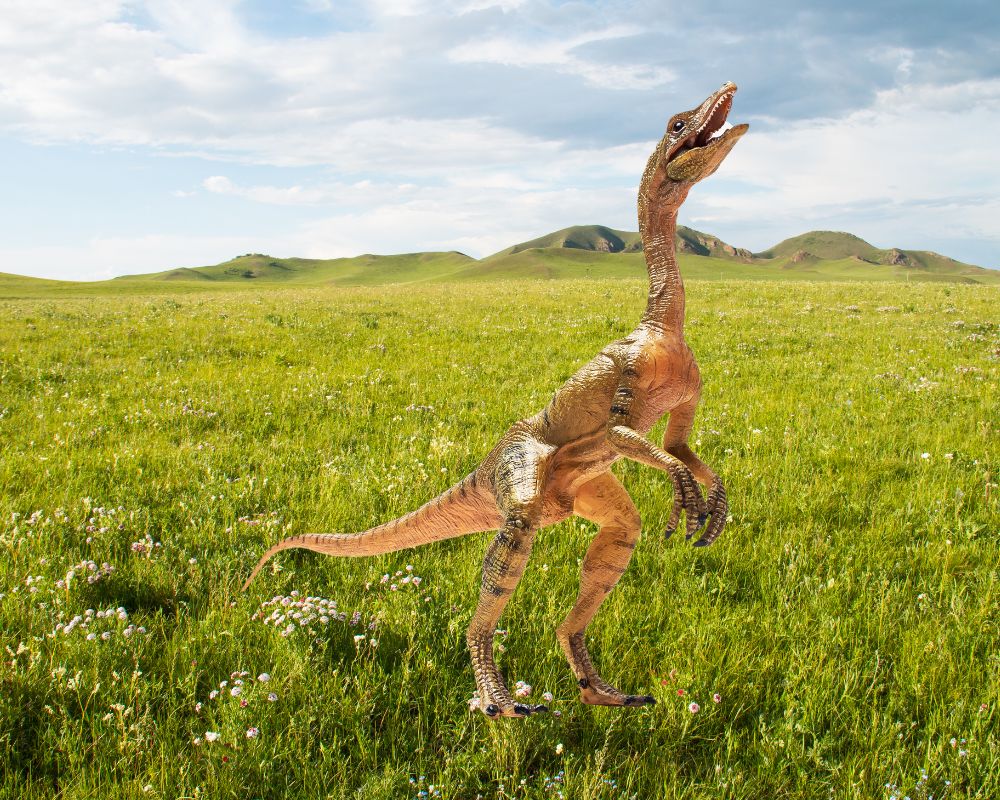The Procompsognathus was one of the earlier dinos, appearing in the Norian age of the late Triassic Period. The Procompsognathus was one of the smallest dinos ever to walk the earth on two legs, and its quickness and well-developed hands made it an excellent hunter and scavenger.
Table of Contents
Some Quick Facts about the Procompsognathus

| Name | Procomsognathus (meaning ”Before Elegant Jaw”) |
| Type of dinosaur | Small Theropod Dinosaur |
| Territory | Dry forested regions, Germany |
| Size | 3 feet long, 10 inches tall |
| Color | Likely green |
| Interesting Characteristics | Rigid, stiff tail and well-developed claws for grasping |
| Diet | Insects, small mammals, and reptiles |
| Major Threats | Natural disasters, larger carnivores |
The Procompsognathus lived about 210 million years ago in what is now Germany. This small theropod dinosaur was featured in books by Michael Crichton (Jurassic Park and The Lost World) but was not included in the movies. Instead, the similar-looking Compsognathus from the Jurassic period was used in the movies.
Though there are few fossils of Procompsognathus available for study, paleontologists know this tiny, quick dino was an integral part of the ecosystem during its lifespan.
Are a Compsognathus and a Procompsognathus the Same?

Initially, paleontologists thought Compsognathus and Procompsognathus were related. But Procompsognathus is not a direct ancestor of the Compsognathus or Compy. This belief was based on visual similarities between the two dinos. The name Procompsognathus even means “before Compsognathus.”
Because their names are so close, these two dinos are confused for each other a lot. The drawings of both species based on their fossil evidence also make it easy to confuse the two. But the Compy lived about 150 million years ago, putting 60 million years between the two species. The Compsognathus was a lot more advanced and even smaller than the Procompsognathus.
Why Was the Procompsognathus So Small?
Dinosaurs from the Triassic period were generally much smaller than dinosaurs that appeared later. Many Triassic period dinos were very long, but only a few were taller than a full-grown human. Of all those, Procompsognathus was one of the shortest, coming in at just 10 inches high.
At only 2 to 3 pounds, the Procompsognathus was about the size of a chicken, but it was 3 feet long from the tip of its nose to the end of its stiff tail.
This small carnivore was a scavenger that often cleaned up the waste of larger dinos. They also ate insects, small reptiles, and small mammals. Their long rear legs and well-formed claws allowed them to chase and grab prey with deadly accuracy. With a sprinting speed of about 30 miles per hour, a Procompsognathus could outrun much of its prey.
Was the Procompsognathus Poisonous?
Procompsognathus was not poisonous or venomous. Currently, there is no evidence to prove any dinosaurs were venomous at all. Because the Procompsognathus fossil evidence is fragmented and incomplete, even if they were venomous, it would be impossible for scientists to say for sure.
Considering their speed and claws, it’s more likely the Procompsognathus had all the tools it needed to hunt without venom. Most venomous creatures surprise their prey and use venom to slow or paralyze faster animals.
The quick-running Procompsognathus could easily catch lizards, insects, and small mammals. They would scavenge for leftovers and dino waste if that didn’t work.
Where Were Procompsognathus Fossils Found?
Fossil evidence of the Procompsognathus was first discovered in Württemberg, Germany, by Albert Burrer in 1909. In 1913, Burrer turned the fossils over to Professor of Paleontology Eberhard Fraas. Eberhard Fraas gave the new dino the type species name Procompsognathus triassicus.
The holotype specimen from that 1909 discovery is SMNS 12591. SMNS stands for State Museum of Natural History at Stuttgart (Germany) where SMNS 12591 still remains. Dinosaurs Efraasia and Plateosaurus were also found in Germany near the quarry where Albert Burrer first discovered Procompsognathus.
Are There More Procompsognathus Fossils?
SMNS 12591 is the only known fossil evidence of the Procompsognathus. In 1921, Frederick Von Huene brought two more partial specimens he believed were Procompsognathus. These specimens included a foot, a partial skull, and part of a jaw (SMNS 12352a and SMNS 12352).
By 1982 and as recently as 2012, the paleontology community was challenging these two specimens. Eventually, SMNS 12352 was labeled as a Crocodylomorph. SMNS 12352a is believed to be an Archosaur.
Since its discovery in 1909, the original fossil evidence of Procompsognathus and the two found by Von Huene have been disputed. At one point, SMNS 12591 was reclassified as a likely Crocodylomorph known as Saltoposuchus.
In 1993, Sankar Chatterjee showed that Procompsognathus was definitely not a Crocodylomorph. In 1998, Chatterjee further proved that Procompsognathus had many of the features of the suborder Theropoda.
Due to the lack of significant fossil evidence, there has been much controversy around Procompsognathus, including whether it truly belonged to the taxon Coelophysidae.
While the dispute was settled in 2008, future discoveries may further challenge what we know about Procompsognathus and its place in dino evolution. With only a single source of fossil evidence for Procompsognathus, experts struggle to prove much about this tiny dino.

